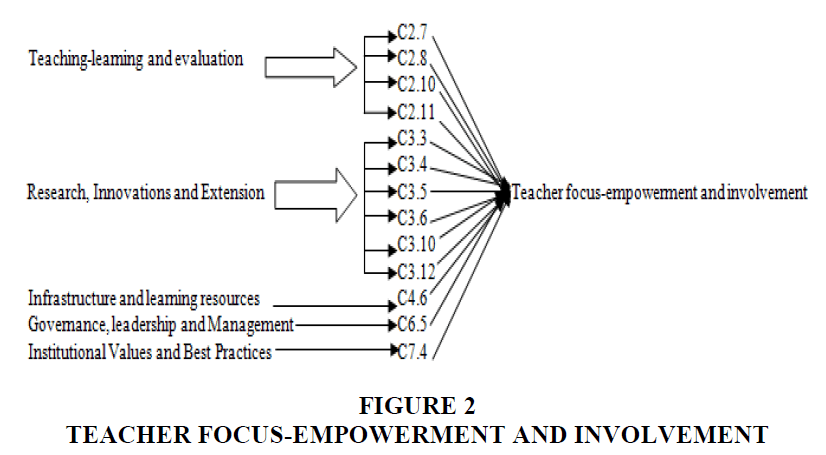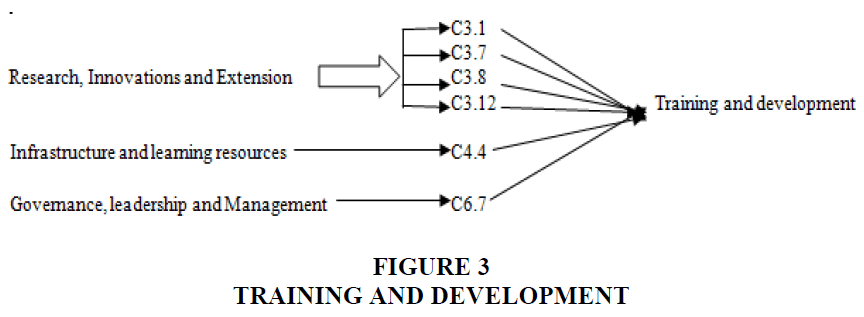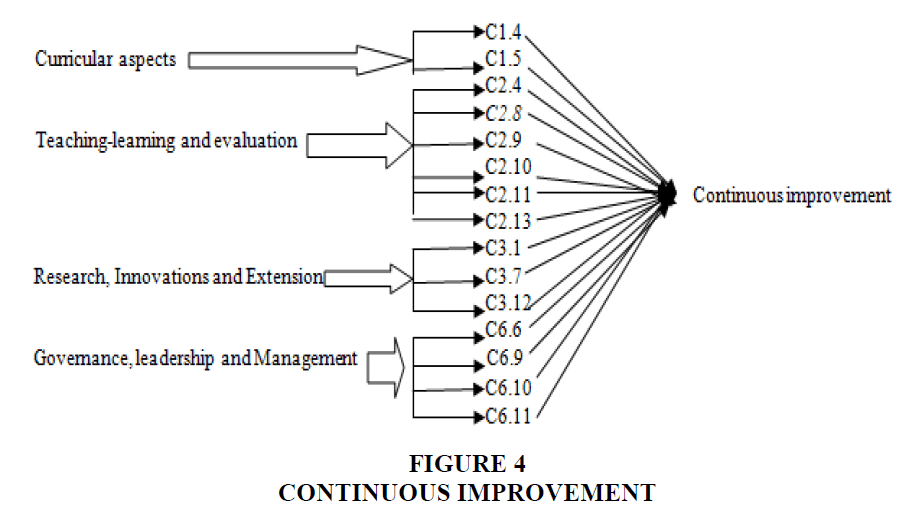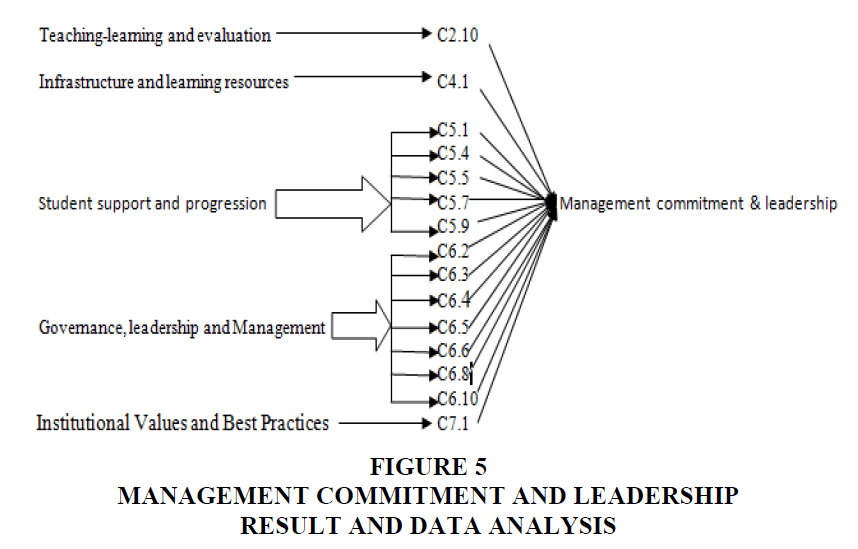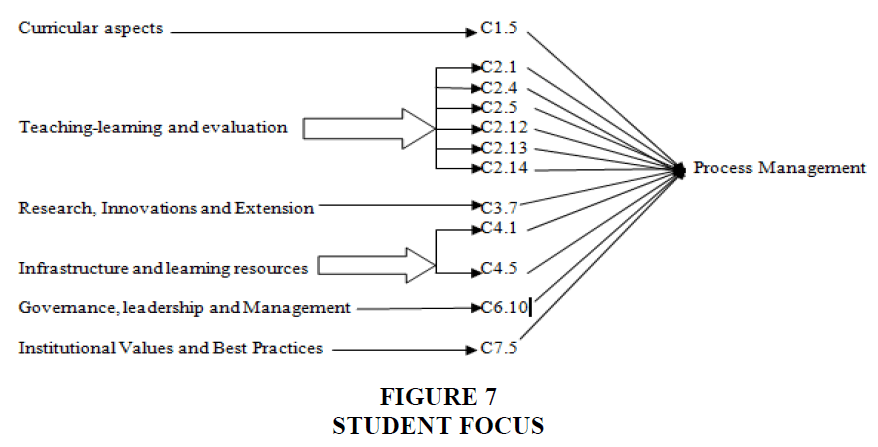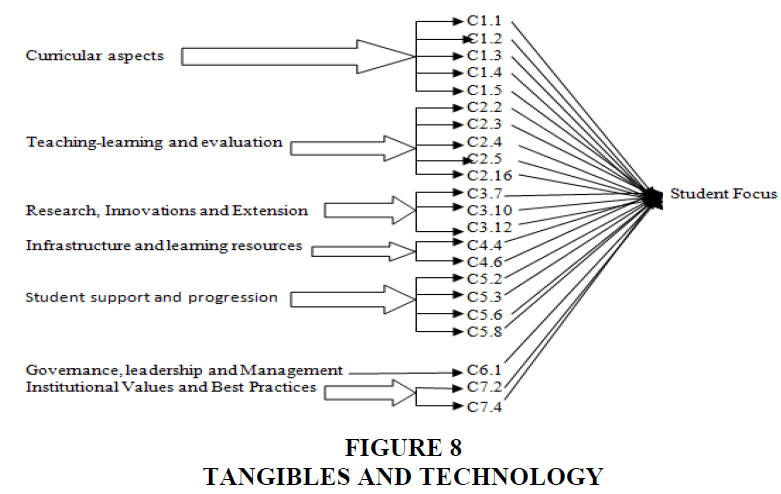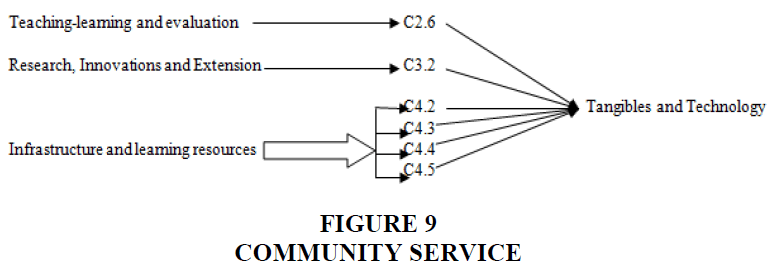Research Article: 2025 Vol: 29 Issue: 5
Aligning and Mapping of Naac Criteria with Tqm Vectors
Sudhir Kumar Acharya, Sri Sri University, Cuttack, Odisha
Biplab Kumar Biswal, Sri Sri University, Cuttack, Odisha
Sudhansu Sekhar Nanda, Sri Sri University, Cuttack, Odisha
Citation Information: Acharya, S.K., Biswal, B.K., & Nanda, S.K. (2025). “Aligning and mapping of naac criteria with tqm vectors". Academy of Marketing Studies Journal, 29(5), 1-14.
Abstract
To become a global leader, India must prioritize high-quality education. In pursuit of this goal, several Higher Education Institutions (HEIs) in India are adopting Total Quality Management (TQM) principles, as proposed by Malcolm Baldrige, to enhance their educational processes. These principles are being utilized in diverse ways to foster nation-building through education. However, a key area of debate is the extent to which TQM practices contribute to meeting the standards required for evaluation and accreditation by organizations such as the National Board of Accreditation (NBA) and the National Assessment and Accreditation Council (NAAC). This paper seeks to map the TQM vectors, based on the Malcolm Baldrige National Quality Award (MBNQA) criteria for the education sector, to the seven criteria established by the NAAC for assessing the quality of HEIs. The MBNQA criteria include key elements such as communication, teacher focus (empowerment and involvement), training and development, continuous improvement, management commitment and leadership, results and data analysis, process management, student focus, tangibles and technology, and community service. These are aligned with the NAAC's seven criteria: curricular aspects; teaching, learning, and evaluation; research, innovations, and extension; infrastructure and learning resources; student support and progression; governance, leadership, and management; and institutional values and best practices. This approach aims to establish a comprehensive framework for enhancing HEIs’ quality through the integration of TQM principles with NAAC standards. By reviewing the NAAC manual for various HEIs, including universities, autonomous colleges, and affiliated/constituent colleges, the authors developed a set of questions by aligning and mapping them to TQM quality vectors. The study's findings reveal a strong correlation between TQM vectors and the seven NAAC quality assessment criteria. Furthermore, the results indicate that HEIs implementing TQM principles are more likely to achieve higher ratings in NAAC accreditation, underscoring the effectiveness of TQM in enhancing institutional quality and meeting accreditation standards.
Keywords
TQM, NAAC, HEIs and Quality Education.
Introduction
The foundation of a nation lies in its educational system, as its educated youth play a pivotal role in steering the country toward the holistic growth of society. As part of a larger national framework, the educational system must not only deliver high-quality education but also emphasize the cultivation of moral, ethical, and societal values.
In India, home to the world's second-largest population, the rapid proliferation of HEIs highlights the critical need for rigorous quality evaluation. To address this, several independent organizations, such as the NBA, NAAC, the University Grants Commission (UGC), and the All India Council for Technical Education (AICTE), have been established to assess and enhance the quality of these institutions.
Established in 1994, the NAAC is an autonomous organization supported by the UGC. Its primary role is to evaluate and accredit Indian HEIs based on their overall quality. NAAC employs seven comprehensive criteria for this evaluation, which are as follows:
1. Curricular Aspects: Focuses on the design and implementation of effective and relevant curricula.
2. Teaching, Learning, and Evaluation: Assesses the teaching-learning processes and their alignment with learner-centric approaches.
3. Research, Innovations, and Extension: Evaluates the institution's contributions to research, innovation, and societal outreach.
4. Infrastructure and Learning Resources: Reviews the adequacy and quality of physical and digital infrastructure and resources.
5. Student Support and Progression: Examines the mechanisms in place for student welfare, support services, and career progression.
6. Governance, Leadership, and Management: Evaluates institutional leadership, governance practices, and administrative effectiveness.
7. Institutional Values and Best Practices: Assesses the promotion of ethical values, inclusivity, and sustainability, along with the adoption of innovative practices.
These criteria collectively ensure a holistic assessment of the institution's quality and performance
Malcolm Baldrige proposed several quality vectors to promote excellence in education, providing a robust framework to support the long-term quality development of HEIs. These quality indicators include:
1. Communication: Ensuring effective and transparent communication channels within and across all levels of the institution.
2. Teacher Focus, Empowerment, and Involvement: Fostering an environment where educators are empowered, engaged, and actively involved in decision-making and continuous improvement processes.
3. Training and Development: Prioritizing professional growth through ongoing training and skill enhancement programs for faculty and staff.
4. Continuous Improvement: Emphasizing a culture of iterative improvement across academic and administrative processes.
5. Management Commitment and Leadership: Demonstrating strong institutional leadership and a commitment to quality at all organizational levels.
6. Results and Data Analysis: Utilizing data-driven approaches to measure performance, track outcomes, and inform decision-making.
7. Process Management: Streamlining and optimizing institutional processes to enhance efficiency and effectiveness.
8. Student Focus: Placing students at the core of institutional activities, addressing their needs, and enhancing their learning experience.
9. Tangibles and Technology: Ensuring the availability of adequate physical resources and integrating modern technologies to support learning and innovation.
10. Community Service: Encouraging institutions to contribute to societal development through outreach programs and community engagement.
These indicators collectively provide a comprehensive framework for fostering excellence and driving sustainable quality improvement in HEIs.
To ensure continuous improvement in delivering high-quality education, HEIs are increasingly adopting TQM techniques. For HEIs implementing these practices to achieve accreditation by the NAAC, it is crucial to establish a clear relationship between NAAC's quality indicators and TQM vectors. Understanding this alignment enables HEIs to strategically integrate TQM principles into their operations, ensuring compliance with NAAC standards while fostering excellence in education.
Review of Literature
Purwati & Kadir (2018) highlighted the priorities that can build a student's achievement index include the lecturer's discipline, research supervision, technological proficiency, assessment method, academic staff's enthusiasm and patience in providing service, English proficiency, teaching and learning environment, and the efficacy of academic information. Platis & Fragouli (2019) identified the TQM vectors that significantly influence customers, employees, society, and organizations include leadership, strategy, human resources, partnerships, resources, processes, and products and services. These vectors collectively drive organizational excellence by fostering a culture of continuous improvement, innovation, and stakeholder satisfaction. By aligning these elements strategically, organizations can enhance performance, deliver superior value, and achieve long-term success while contributing positively to societal well-being. Zanqar et al. (2019) from their study indicated that in order to deliver effective, high-quality education, educational institutions must adopt TQM principles, which encompass key concepts such as customer focus, leadership, employee involvement, quality processes, continuous improvement, data-driven decision-making, and relationship management. By integrating these elements, institutions can create an environment that prioritizes student success, fosters collaboration, and drives innovation, ultimately enhancing the overall educational experience and institutional performance. El Hawi & Alzyadat (2019) from their study revealed TQM concepts play a crucial role in driving organizational excellence. The authors found that student satisfaction and quality improvement are profoundly influenced by factors such as active participation in decision-making processes, collaboration between employers and employees, and the realization of social justice. Additionally, the evaluation of quality across all inputs and the focus on development—through continuous learning, meeting evolving demands, and consistently managing and improving key activities and programs—significantly enhance institutional effectiveness and the overall educational experience. Kistiani & Permana (2020) in their study depicted that organization will steadily progress toward its vision while building global competency through the consistent preparation and implementation of annual quality plans. A strong focus on TQM will further enhance this journey. By fostering employee understanding of TQM's benefits, ensuring executives prioritize quality in decision-making, strengthening the organizational infrastructure, and conducting regular reviews, the company will position itself to gain a significant competitive advantage. Kwarteng (2021) from his study found out student satisfaction is influenced by the quality of services provided and the employer's commitment to core values. However, the findings indicate a generally low level of satisfaction among all respondents. Indiya et al. (2021) stated that organizational culture plays a significant role in influencing performance, as the interaction within the culture actively enhances an organization's overall effectiveness. Texeira-Quiros et al. (2022) highlighted that internationalization, innovative strategies, teacher training, and empowerment are strongly correlated with the performance of HEIs. Rahardja et al. (2018) revealed leadership, skills, and motivation significantly influence the accreditation of HEIs for delivering high-quality education. The authors also revealed that while leadership negatively affects performance improvement, skills and motivation have a substantial positive impact. This, in turn, contributes positively to achieving favourable institutional accreditation outcomes. Prasad et al. (2019) highlighted that several regulatory measures play a vital role in helping HEIs achieve NAAC and NBA accreditation, thereby ensuring high-quality education. These measures include mandatory accreditation of institutes and programs, relaxation in the five-year Ph.D. recruitment process, and requiring faculty to pass national-level exams. Additionally, establishing residential campuses for technical institutions, conducting national entrance exams, providing student scholarships, financial aid programs further support HEIs in maintaining academic excellence and achieving accreditation. Suryawanshi & Shinde (2019) from their study revealed- NAAC accreditation plays a crucial role in ensuring the quality of higher education institutions. The authors emphasize that maintaining high-quality education requires continuous monitoring and support from the institution's Internal Quality Assurance Cell (IQAC). Gupta & Choubey (2021) in their work revealed that autonomy of HEIs is largely sustained by key facilitating factors, including the presence of qualified faculty and staff, a culture of trust and confidence, clear accountability for delivering high-quality education, supportive laws and regulations, professional leadership, ownership of institutional plans, effective stakeholder collaboration and networks, robust fund generation, adherence to international governance policies, and adequate funding from both public and private sources. Ghatole & Dahikar (2021) highlighted that accreditation process now includes several newly added quality indicators, such as the student satisfaction survey (SSS), data validation and verification (DVV), quality benchmarking, innovation ecosystems, alumni engagement, and institutional values and distinctiveness. These elements enhance the evaluation framework, ensuring a comprehensive assessment of institutional performance and impact. Ravikumar et al. (2021) in their study depicted- NAAC evaluation is closely linked to the quality assurance activities of HEIs, highlighting the critical role of NAAC accreditation in maintaining, improving, and sustaining the quality of HEIs. Singh et al. (2021) in their study concluded that HEIs can enhance their overall quality of education and secure NAAC accreditation by adopting innovative practices such as mobilizing resources, maintaining department-specific documentation, strengthening ICT infrastructure, fostering public-private partnerships, implementing application-based teaching methodologies, offering job-oriented courses, promoting research, conducting workshops on professional ethics and value education, digitizing libraries, aligning feedback mechanisms, collaborating with industries, and engaging in social activities. These initiatives collectively contribute to institutional growth and academic excellence. Pathak & Pawar (2022) in their study explored the key factors influencing student enrolment in higher education are campus amenities, affordability, and location. Students are particularly motivated to enrol in accredited institutions with a strong placement record, as well as those that offer a high-quality teaching and learning environment. These elements play a significant role in attracting prospective students. Aithal & Maiya (2023) in their study revealed the key pillars supporting educational excellence and the continuous development of HEIs include innovative teaching approaches, effective curriculum design, robust assessment procedures, and a strong institutional culture. These elements are essential for fostering an environment of academic growth and institutional progress. Prakash (2023a) in his study on quality of HEIs concluded while investment potential has a limited direct impact on HEI efficiency, it plays a key role in mediating the evaluation of HEI quality. Infrastructure positively influences HEI efficiency and enhances teaching and learning processes. Additionally, research and governance are critical factors that significantly affect the overall effectiveness of HEIs. Prakash et al. (2023b) from their study revealed- NAAC plays a crucial role in ensuring the quality of higher education institutions (HEIs) through its accreditation and assessment processes. The authors also explained the NAAC grading system and the importance of evaluation, highlighting how both qualitative and quantitative elements of the self study report (SSR) contribute to the assessment process, specifically within the A and A procedures for Indian HEIs. Tripathi & Bhavsar (2022) disseminated in their study that HEIs offering post-graduate programs tend to receive significantly higher accreditation ratings in urban areas, while those in rural areas generally have lower ratings. The study highlights the developmental implications of these findings for all HEI stakeholders, emphasizing the need for targeted improvements across different regions.
Summary
Numerous researchers have highlighted the significant role that TQM vectors in enhancing the quality of HEIs. In India, accreditation status is awarded based on the quality scores of HEIs, which are assessed by the NAAC. Therefore, aligning TQM principles with NAAC's seven criteria is crucial for helping HEIs identify and address gaps in their quality management practices. This alignment can effectively support institutions in preparing for NAAC certification and evaluation Figures 1-10.
Figure 12 Communication
Research Objective
To identify whether the TQM vectors are aligned and mapped with seven criteria of NAAC.
Hypothesis
H1: There is a proper alignment and mapping exists between TQM vectors and seven criteria of NAAC.
Methodology
The authors have analysed the NAAC manual's quality assessment methods for HEIs and developed a set of criterion-based questions to address this objective. These questions have been reviewed and validated by experts from Utkal University in Bhubaneswar, Odisha. To establish their interrelation, the questions are subsequently grouped under various TQM vectors.
Questions based on NAAC Criteria1
Curricular aspect (Criterion-1)
C1.1. The curriculum enhances students' employability by focusing on skill development.
C1.2. The curriculum provides opportunities to foster entrepreneurship development among students.
C1.3. The curriculum offers academic flexibility in terms of duration and interdisciplinary options.
C1.4. The institution offers value-added courses and organizes activities aimed at the continuous development of human values and professional ethics.
C1.5. Regular feedback is collected from all stakeholders to assess how well the curriculum addresses the needs of society, the economy, and the environment.
Teaching, Learning and Evaluation (Criterion-2)
C2.1. Student enrolment is conducted with transparency and fairness, taking into account factors such as community, geography, socio-economic status, and educational background.
C2.2. The institution is committed to addressing the needs of students from diverse backgrounds and demographics.
C2.3. An initial assessment is conducted to evaluate students' learning levels.
C2.4. Students' progress is continuously assessed throughout the year.
C2.5. The institution adopts participative, experiential, and collaborative learning approaches to engage students effectively.
C2.6. The institution integrates technology into the teaching-learning process.
C2.7. Teachers are proficient in using Learning Management Systems (LMS) and other e-resources to deliver high-quality teaching.
C2.8. The institution provides opportunities for professional growth through teachers' learning and development programs.
C2.9. Teachers possess up-to-date knowledge of the latest developments, enabling them to innovate and consistently seek improvement in their teaching practices.
C2.10. Teachers are recognized for their exceptional teaching abilities.
C2.11. Teachers consistently strive for both individual and institutional excellence.
C2.12. The institution regularly evaluates the teaching-learning process, as well as the knowledge and skills gained by stakeholders through various programs.
C2.13. The institution ensures regularity, transparency, and prompt action in addressing any errors that may arise during the examination process.
C2.14. The quality of the questions aligns with both academic standards and societal needs.
C2.15. The performance of students is evaluated in relation to the defined learning outcomes.
C2.16. The level of student satisfaction, comfort, and intellectual stimulation is consistently assessed in relation to the teaching-learning and evaluation processes.
Research, Innovations and Extension (Criterion-3)
C3.1. The institution fosters a strong research culture and actively encourages teachers to engage in research and innovation.
C3.2. The institution is equipped with adequate infrastructure to support research and innovation.
C3.3. The institution has established collaborations with other institutions, agencies, and research bodies to facilitate collaborative research.
C3.4. The institution encourages research work by providing adequate funding.
C3.5. Faculty members are research-oriented and actively engage in research activities.
C3.6. The institution actively promotes and motivates interdisciplinary and interdepartmental research.
C3.7. The institution regularly conducts workshops and seminars for the continuous development of both teachers and students.
C3.8. Does the institution award and recognize teachers or students for innovative start-ups?
C3.9. The institution offers learning activities that address social issues such as community challenges, gender disparities, and social inequality.
C3.10. The institution has established collaborations with other institutions, industries, and agencies of professional and social relevance.
C3.11. The institution facilitates regular exchange programs for students and faculty, along with the sharing of research and resources with other organizations and institutions.
C3.12. The institution has formal agreements and understandings with other organizations and institutions for training, student and faculty exchange, as well as research and resource sharing.
Infrastructure and Learning Resources (Criterion-4)
C4.1. The institution is equipped with adequate physical infrastructure to support both academic and administrative activities.
C4.2. The institution provides adequate physical infrastructure to support both curricular and extra-curricular activities.
C4.3. The institution provides adequate access to books, journals, magazines, and e-resources for both teachers and students.
C4.4. The institution utilizes an Integrated Library Management System (ILMS) for efficient library operations.
C4.5. Faculty and students have access to Information and Communication Technology (ICT) facilities, along with other learning resources.
C4.6. The institution allocates resources on a regular basis for the maintenance and upkeep of its infrastructure.
Student support and progression (Criterion-5)
C5.1. The institution has a dedicated student guidance and placement cell to support career development and job placement.
C5.2. The institution has an effective grievance redressal cell to address and resolve student and staff concerns.
C5.3. The institution offers provisions for scholarships and fee waivers to support students financially.
C5.4. The institution provides placement facilities to students, assisting them in securing employment opportunities.
C5.5. Students who qualify state, national, or international level exams are recognized and encouraged for their achievements..
C5.6. The institution actively works on social responsibility initiatives, contributing to the well-being of the community and society at large.
C5.7. Value-based education focused on social responsibility helps students develop various skills and competencies, preparing them to contribute meaningfully to society.
C5.8. The institution has a strong alumni association that plays a key role in mobilizing both financial and non-financial resources.
C5.9. Alumni contribute significantly to students' placement by offering guidance, networking opportunities, and facilitating job placements.
Governance, leadership and management (Criterion-6)
C6.1. The management provides a clear and distinct vision and mission that guide the institution's growth and development.
C6.2. The institutional objectives are aligned with and effectively support the vision statement, ensuring a clear direction for the institution's growth.
C6.3. The institution encourages participative decision-making, involving various stakeholders in the process to ensure a collaborative approach to decision-making.
C6.4. The institution promotes coordination between academic and administrative staff, fostering collaboration for strategic planning and implementation to achieve its vision.
C6.5. The institution has clear objectives, directives, and guidelines for both academic and administrative aspects, ensuring a structured approach to quality development.
C6.6. The institution conducts regular performance appraisals to enhance the professional competence of faculty and staff.
C6.7. The institution ensures transparency in mobilizing and allocating financial resources, promoting accountability and effective resource management.
C6.8. The institution conducts regular internal and external audits of its income and expenditure to ensure financial accountability and transparency.
C6.9. The institution has a well-functioning Internal Quality Assurance Cell (IQAC), managed by representatives from various stakeholders, ensuring continuous quality improvement.
C6.10. The institution conducts regular academic and administrative audits, maintaining transparency in the process to ensure accountability and continuous improvement.
C6.11. The institution adopts strategies aimed at the quality development of both academic and administrative aspects, ensuring continuous improvement across all areas.
Institutional values and best practices (Criterion-7)
C7.1. The institution organizes gender equality programs periodically to promote awareness and foster an inclusive environment.
C7.2. The institution is sensitive to climatic and environmental issues and actively adopts eco-friendly practices and waste management strategies to promote sustainability.
C7.3. The institution is committed to promoting human values and professional ethics, integrating them into its educational framework and activities.
C7.4. The institution employs innovative practices in its functioning, which help streamline operations and improve overall efficiency.
C7.5. Any measure taken which make the institution distinct?
Malcolm Baldrige TQM vectors
According to the Malcolm Baldrige framework, the key quality vectors for the overall development of Higher Education Institutions (HEIs) are communication, teacher focus, empowerment and involvement, training and development, continuous improvement, management commitment and leadership, results and data analysis, process management, student focus, tangible resources and technology, and community service. These vectors collectively contribute to fostering a culture of excellence, driving innovation, and ensuring sustained quality improvement across all aspects of institutional functioning Table 1.
| Table 1 Number and Percentage of NAAC Questions Mapped with TQM Vectors | |||
| Sl. No. | TQM Vectors | Number of NAAC Questions | Percentage out of 64 questions |
| 1 | Communication | 6 | 9% |
| 2 | Teacher focus-empowerment and involvement | 13 | 20% |
| 3 | Training and development | 6 | 9% |
| 4 | Continuous improvement | 15 | 23% |
| 5 | Management commitment and Leadership | 15 | 23% |
| 6 | Result and data analysis | 3 | 5% |
| 7 | Process management | 12 | 19% |
| 8 | Student focus | 22 | 34% |
| 9 | Tangibles and technology | 6 | 9% |
| 10 | Community Service | 10 | 16% |
Grouping of NAAC questions (Criterion wise) with Baldrige TQM vectors
The various questions from NAAC criteria are grouped under the different quality vectors of Malcolm Baldrige as follows.
Communication (C2.1, C2.13, C6.2, C6.6, C6.10, C6.11)
Teacher focus-empowerment and involvement (C2.7, C2.8, C2.10, C2.11, C3.3, C3.4, C3.5, C3.6, C3.10, C3.12, C4.6, C6.5, C7.4)
Training and development (C3.1, C3.7, C3.8, C3.12, C4.4, C6.7)
Continuous improvement (C1.4, C1.5, C2.4, C2.8, C2.9, C2.10, C2.11, C2.13, C3.1, C3.7, C3.12, C6.6, C6.9, C6.10, C6.11)
Management commitment and Leadership (C2.10, C4.1, C5.1, C5.4, C5.5, C5.7, C5.9, C6.2, C6.3, C6.4, C6.5, C6.6, C6.8, C6.10, C7.1)
Result and data analysis (C2.3, C2.12, C2.15)
Process management (C1.5, C2.1, C2.4, C2.5, C2.12, C2.13, C2.14, C3.7, C4.1, C4.5, C6.10, C7.5)
Student focus (C1.1., C1.2., C1.3., C1.4., C1.5, C2.2, C2.3, C2.4, C2.5, C2.16, C3.7, C3.10, C3.12, C4.4, C4.6, C5.2, C5.3, C5.6, C5.8, C6.1, C7.2, C7.4)
Tangibles and technology (C2.6, C3.2, C4.2, C4.3, C4.4, C4.5)
Community Service (C1.1, C3.9, C3.10, C3.11, C3.12, C5.7, C5.9, C7.2, C7.3, C7.4)
(Source: grouping of questions is made by the authors)
Mapping and alignment of questions of NAAC 7-criteria with individualBaldrige TQM vectors
Findings
The analysis illustrates that all the questions derived from the seven NAAC criteria have been systematically grouped into various quality vectors as postulated by Malcolm Baldrige. The majority of the questions (22) are grouped under Student Focus, contributing 34% to the total. The categories Management Commitment and Leadership, Continuous Improvement, Teacher Focus-Empowerment and Involvementand Process Management account for 23%, 23%, 20%, and 19% of the questions, respectively. Similarly, the categories Community Service, Communication, Training and Development, Tangibles and Technology and Result and Data Analysis account for 16%, 9%, 9%, 9%, and 5% of the questions, respectively. This highlights a clear and effective alignment between the TQM vectors and the seven criteria of NAAC.
Conclusion
NAAC assesses the quality of HEIs through DVV of quantitative metrics (QnM) and Peer Team Review for qualitative metrics (QlM). The weightage distribution varies based on the type of institution:
1. For affiliated/constituent colleges, QnM contributes 62%, while QlM accounts for 38%.
2. For autonomous colleges, the weightage is 56% for QnM and 44% for Ql
3. For universities, the weightage is 65% for QnM and 35% for Ql
This distribution underscores the varying emphasis on quantitative and qualitative metrics across different categories of institutions.
The analysis and findings reveal a strong correlation between Malcolm Baldrige quality vectors and the seven NAAC criteria for HEIs’ quality assessment. Most of the NAAC questions are categorized under one of the following key areas: process management, teacher empowerment and involvement, continuous improvement, management commitment and leadership, or student focus. This indicates that during the assessment and accreditation process, NAAC places greater emphasis on these TQM quality vectors, which are fundamentally aligned with its quantitative metrics. A comparatively smaller number of questions are grouped under community service, communication, training and development, tangibles and technology and result and data analysis, indicating that NAAC places relatively less emphasis on these quality vectors, which are primarily aligned with its qualitative metrics.
Suggestion
As highlighted in the discussion above, NAAC is assessing the quality practices of HEIs, which correspond to the TQM quality vectors, as part of its evaluation process to determine their accreditation status. Therefore, HEIs must follow, adapt, and adhere to TQM principles for their continuous quality improvement to achieve NAAC accreditation. This will not only help establish a sustainable brand reputation and goodwill in the public but also enable HEIs to make a substantial contribution to nation-building and the overall development of society. Similar studies should be conducted to map the relationship between TQM principles and the accreditation processes of other accrediting agencies, aiming to enhance the quality assurance of HEIs in India.
Endnotes
1All the questions are developed by the authors consulting with experts, and by analysing the NAAC manual for quality assessment.
2All the figures are developed by the authors.
References
Aithal, P. S., & Maiya, A. K. (2023). Exploring Quality in Higher Education: An Introduction and Theoretical Framework. International Journal of Philosophy and Languages (IJPL), 2(2), 98-114.
Indexed at, Google Scholar, Cross Ref
El Hawi, R., & Alzyadat, W. (2019). TQM Measured Students' Satisfaction in the Jordanians' Private University for Achieving Institutional Excellence. TEM Journal, 8(2).
Ghatole, S. M., & Dahikar, P. B. (2021). NAAC Accreditation: A Quality Initiative Reform in Indian Higher Education. The Research Journal (TRJ): A Unit of I2OR, 7(1), 42-47.
Gupta, B. L., & Choubey, A. K. (2021). Statistical Analysis of Facilitating and Impeding Factors for the Sustenance of Autonomy. Asian Journal of Management, 12(3), 258-264.
Indiya, G. D., Mise, J., Obura, J., & Ojera, P. (2021). Moderating effect of organization culture on the relationship between quality management system adoption and performance of public universities in Kenya. African Journal of Business Management, 15(2), 70-78.
Indexed at, Google Scholar, Cross Ref
Kistiani, D. P., & Permana, J. (2020, February). The Importance of Application Total Quality Management at Higher Education. In 3rd International Conference on Research of Educational Administration and Management (ICREAM 2019) (pp. 177-180). Atlantis Press.
Kwarteng, A. J. (2021). An assessment of outcome criteria associated with the implementation of TQM in a higher education institution in Ghana. Cogent Education, 8(1), 1859198.
Pathak, R., & Pawar, S. (2022). Study on Impact of Accredited Institutes during Student Enrollment In Higher Education. Academy of Marketing Studies Journal, 26(S6).
Platis, C., & Fragouli, E. (2019). TQM in higher education institutions: the case of HSJ. International Journal of Higher Education Management, 6(1).
Prakash, P. (2023). Linkages between Investment Potential and Quality of Educational Institutions: Evidence from India. Education Research International, 2023(1), 7134548.
Indexed at, Google Scholar, Cross Ref
Prakash, P., Gornale, S. S., ShyamaSundar, M. S., & Siddalingappa, R. (2023). The Role of the National Assessment and Accreditation Council in Ensuring Quality Education in the Indian Education System: An Analysis of Its Accreditation Standards and Grading Practices. British Journal of Multidisciplinary and Advanced Studies, 4(6), 1-18.
Prasad, G. D., Ray, G. D., & Mangam, V. (2019). Accreditation of self-financing technical institutions in India: A new perspective to improve quality. Journal of Engineering Education Transformations, 32(4), 48-55.
Purwati, A. A., & Kadir, E. A. (2018). Quality Evaluation on Private Higher Education Institutions in Pekanbaru, Indonesia (Integrating Kano Model and Quality Function Deployment). Revista ESPACIOS, 39(17).
Rahardja, U., Moein, A., & Lutfiani, N. (2018). Leadership, competency, working motivation and performance of high private education lecturer with institution accreditation B: Area kopertis IV Banten province. Man India, 97(24), 179-192.
Ravikumar, K., Samanta, S., Rath, A. K., & Srinivasaragavan, S. (2021). Quality assessment of Indian universities: An analytical study of NAAC accreditation scores. Psychology and education journal, 58(2), 5903-5914.
Indexed at, Google Scholar, Cross Ref
Singh, R., Verma, H., & Kiran, C. (2020). An Overview of Accreditation Status of Higher Education Institutions of Haryana. In Proceedings of NAAC Sponsored Online National Conference on Quality Enhancement in HEIs and Evaluation with RAF of NAAC (pp. 1-12).
Suryawanshi, V. S., & Shinde, V. S. (2019). NAAC Assessment: A Boost for Higher Education. International Multidisciplinary E-Research Journal. ISSN, 2348-7143.
Texeira-Quiros, J., Justino, M. D. R., Antunes, M. G., Mucharreira, P. R., & Nunes, A. D. T. (2022). Effects of innovation, total quality management, and internationalization on organizational performance of higher education institutions. Frontiers in Psychology, 13, 869638.
Indexed at, Google Scholar, Cross Ref
Tripathi, R., & Bhavsar, V. Investigating Factors Affecting Accreditation Score of Higher Educational Institutions: A Case of Chhattisgarh.
Zanqar, F. S. M., Khatibi, A., Azam, S. F., & Tham, J. (2019). The challenges of total quality management on education quality in UAE. European Journal of Economic and Financial Research.
Indexed at, Google Scholar, Cross Ref
Received: 21-Apr-2025, Manuscript No. AMSJ-25-15866; Editor assigned: 22-Apr-2025, PreQC No. AMSJ-25-15866(PQ); Reviewed: 20-May-2025, QC No. AMSJ-25-15866; Revised: 03-Jun-2025, Manuscript No. AMSJ-25-15866(R); Published: 05-Jul-2025

